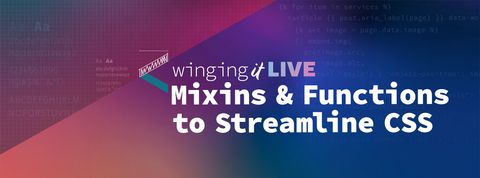This post is part of a series on CSS logical shorthands:
What are flow-relative ‘logical’ properties?
The specification for
CSS Logical Properties & Values
was first published as a
Working Draft
in 2017,
almost three years after
the first GitHub commit.
In many ways,
this is an offshoot of the
spec for CSS Writing Modes
first published in 2010.
Writing Modes define
how the text flows in a document.
Many languages are written horizontally
(either left-to-right or right-to-left)
with lines of text stacking
from top to bottom.
This is the default horizontal-tb writing mode.
But some languages can also be written vertically,
and stack in either direction:
vertical-lr or vertical-rl.
In any given writing mode,
text creates lines on one axis,
and those lines wrap to stack up on the cross axis.
We call those the inline and block axes respectively.
This allows us to use
‘flow-relative’ or ‘logical’ language
in place of the ‘physical’ terms
that CSS started with:
- Axes:
horizontal/x and vertical/y
are always fixed in place,
but inline and block
change relative to the writing mode.
- Directions & sides: If we also account for
the text direction (
rtl or ltr) then the
top, right, bottom, and left sides
can be replaced with
inline-start, inline-end, and so on.
- Dimensions: The
width and height
of an element can be described
as the inline-size and block-size.
Side quest:
The original specifications
use length (or later extent) and measure to describe
the block and inline dimensions.
That eventually became block-size and inline-size in 2014,
which I think is a big improvement for clarity.
I trace this history in my notes,
with links to all the discussion I can find.
CSS Logical Properties & Values Module Level 1
defines a number of flow-relative values
for existing properties such as flow, clear,
text-align, and resize.
Then it defines two logical dimension properties –
inline-size and block-size –
and a list of logical sub-properties
for margin-<side>, padding-<side>, and border-<side>.
What about logical shorthands?
CSS provides several 2-value
logical shorthand properties,
allowing us to specify
both -start and -end
values on either the inline or block axis.
I find these extremely useful
for quickly setting the margin-block,
border-block, and padding-block on elements:
See the Pen 2-Value Logical Shorthands by @miriamsuzanne on CodePen.
Side quest:
These 2-value properties
don’t have any physical counterparts.
There is no margin-vertical or margin-y property.
Should there be?
Let us know what you think
on Mastodon
or Bluesky!
The Logical Properties spec also
includes a proposal
that was never implemented by browsers,
so that we can use the existing
4-value margin, padding, or border shorthands
to set the logical rather than physical values.
Since these properties already exist
and have a purely physical meaning,
it’s a bit more work.
But the spec adds an optional logical keyword
that can be set before the value:
blockquote {
margin: logical 1em 2em 3em 4em;
}
blockquote {
margin-block-start: 1em;
margin-inline-start: 2em;
margin-block-end: 3em;
margin-inline-end: 4em;
}
That’s one of four approaches
discussed in a 2017 Github issue
which Elika Etimad (fantasai)
opened a few weeks before publishing the spec:
- Add a keyword like
logical or relative to the value
- Use a flag like
!logical or !relative to toggle declarations
- Create new shorthands like
margin-logical and padding-logical
- Add a single toggle property like
margin-mode: relative
For now we’ll set aside
finding the right word (logical, relative, or something else),
and focus on choosing a mechanism:
keyword, flag, special shorthands, or toggle.
These all have potential issues –
which I’ll cover with more detail
in the another post –
but option 4 raises an important issue
we should address right away.
Is a global solution possible?
The first three proposals are declaration-level solutions,
which we have to repeat
every time we use the shorthand syntax.
The result is a logical shorthand
that’s significantly less short
than the physical alternatives.
That might be okay as a partial fix,
but if we stop there
logical shorthands still feel
like a second-class feature.
That’s a big problem for the language.
It’s hard to encourage a logical-first approach as the best practice,
when the language is clearly giving preference
to physical values instead.
Will it still make sense 10 years from now,
or will it always feel like
a mistake
we’re stuck with for legacy reasons?
A toggle like margin-mode would be one approach to that,
similar to the box-sizing property.
I’m not sure we would actually need
different mode-toggles for each shorthand,
so let’s call it shorthand-mode for now.
But that still comes with some significant issues.
First,
we have to consider the order of the values.
I don’t know why Bert Bos and Håkon Lie
used the clockwise
top-right-bottom-left ordering
for 4-value properties.
The best thing about it
is the alternating-axis,
which allows us to shorten things even more –
down to 3 values, 2 values, or even a single value:
article {
margin: 1em 2em 3em 4em;
margin: 1em 2em 3em;
margin: 1em 2em;
margin: 1em;
}
That would still be possible
if we went counter-clockwise,
and everything else about it would make more sense.
Given a default horizontal-tb writing mode
and the default ltr text direction,
why do we set the block-start first,
then the inline-end?
Why is the inline-start at the very end?
Given this reality,
if we assume the default flow of text
and try to directly transpose
the syntax from physical to relative,
it looks strange:
block-start then inline-end,
block-end, and inline-start.
Sure, I could learn that –
but it has absolutely no logic to it
outside that direct transposing of defaults.
If the entire goal is to have
a flow-relative set of values,
they should have a flow-relative order as well.
That’s why grid syntax (for example)
uses block-start and then inline-start,
and then the alternating -end values.
That leads to the second issue:
Any global toggle will be applying
action-at-a-distance.
The toggle is not positioned in our code
next to the values that it will impact.
When we encounter a margin of 1em 2em 3em 4em,
we have no idea what that value means
until we find the toggle.
If that toggle is another value in the cascade,
there is no way to know what mode we’re in
before rendering the page,
and allowing the cascade to resolve.
This works okay for box-sizing,
which only impacts the width and height properties.
We can set the toggle on an element
as we size it,
and generally assume the three properties
will cascade together.
If a third-party tool is using a different mode
to size specific components,
we can make sure the right box-sizing is applied
on those components specifically.
But there are many properties
that could accept logical properties,
and they aren’t always clearly related.
Are we sure we want
scroll-snap-margin to use the same mode
as border-radius and box-shadow and background-position?
Are we going to create distinct toggles for each?
Finding a path forward
We can continue to discuss
the pros and cons of each syntax,
but this is where we’re forced to step back
and consider the bigger question:
No one knows the full list of CSS properties
that will be impacted by our choice.
- Before we can pursue a global toggle
(cascading or otherwise)
we have to know which properties will be impacted,
and what that impact looks like
on each individual property.
- Even when we provide a global toggle,
we will likely need a per-property syntax
to opt-out in specific situations.
That means we need a property syntax first,
even if we plan on a global solution later.
- We can’t even determine
which of our proposed declaration-level solutions are viable
without seeing the full list of properties
where they will be applied.
We will also have to consider the serialization
and CSSOM representations for each property.
We can get into all of that
in more detail later,
but the current blocker is clear –
and it’s been blocking this issue
for several years now…
We need to know what we’re talking about
Before anything else can move forward,
someone has to make a list
of all the shorthand properties that accept physical dimensions,
but should allow logical dimensions as well.
That’s a lot of research,
and that’s what we’re
currently trying to fund.
Are you willing to help support that work?



